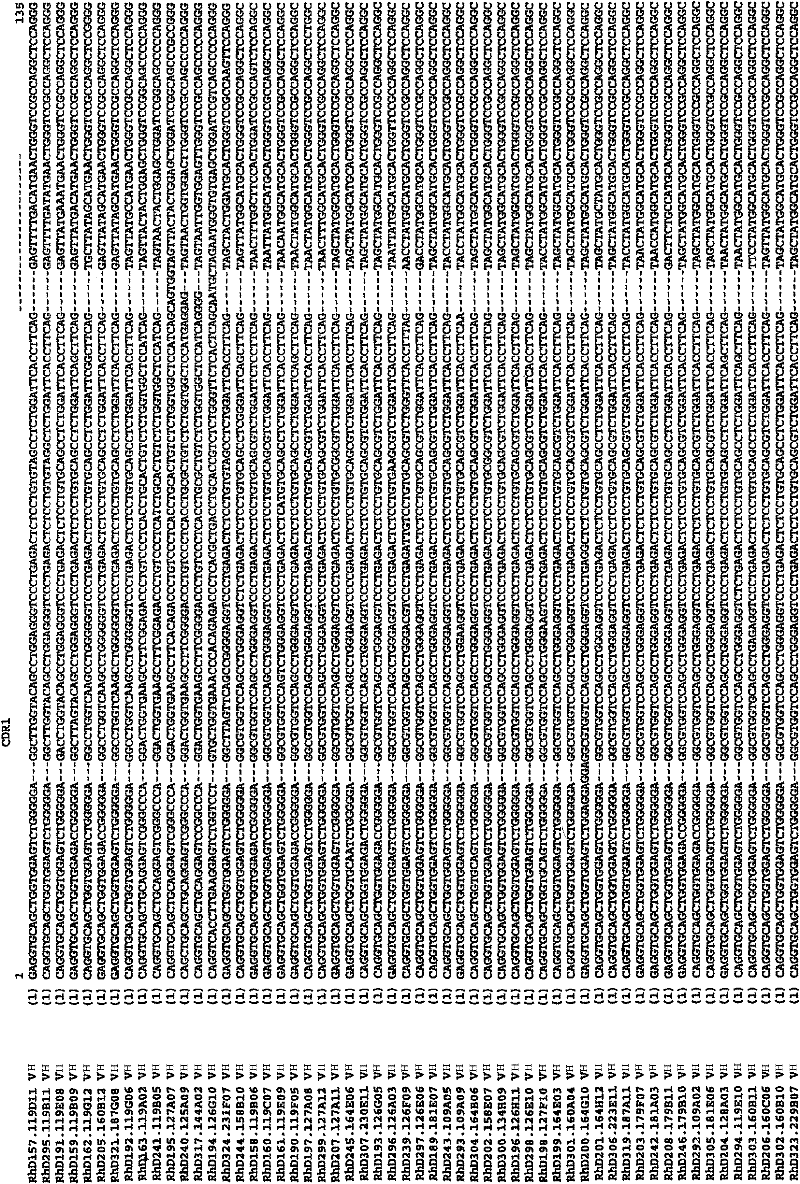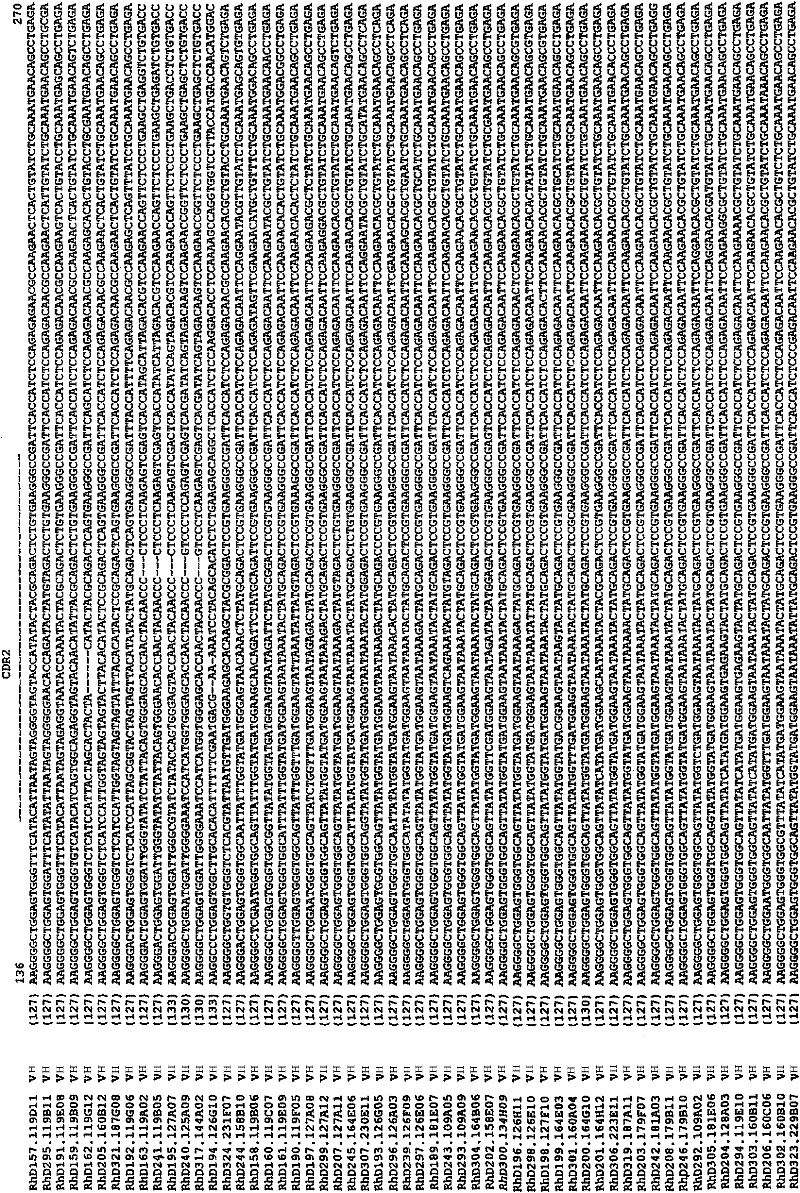Treatment of thrombocytopenia
A technology for thrombocytopenia and hemoglobin, applied in blood diseases, anti-blood group antigen immunoglobulin, extracellular fluid diseases, etc., can solve ineffectiveness, prolonged half-life of red blood cells, monoclonal anti-D antibody can not be used to treat autoimmunity, etc. problem, to achieve the effect of effective ITP treatment and safe ITP treatment
- Summary
- Abstract
- Description
- Claims
- Application Information
AI Technical Summary
Problems solved by technology
Method used
Image
Examples
Embodiment 1
[0197] Production of recombinant polyclonal antibodies against Rhesus D
[0198] donor
[0199] Donors were registered with Aalborg Sygehus Nord. A total of 8 RhD(-) females were immunized with RhD(+) erythrocytes derived from RhD(+) individuals. The donors had different immunization histories with respect to the number of boosts and the source of RhD(+) red blood cells used for immunization. Immunization histories of different donors are given in Table 1.
[0200] Table 1
[0201] Donor ID#
Boost times
Number of promotions from different sources
1
3
2
2
6
2
[0202] 3
2
1
4
4
4
5
2
2
6
3
2
7
2
2
8
2
2
[0203]Monocytes were collected by leukapheresis 5-7 days after the last boost. Cells were pelleted from a commercially available RNA preparation kit and immediately transferred to cell lysis solut...
Embodiment 2
[0288] Generation of polyclonal cell pools for larger scale production
[0289] 27 cell cultures were selected to constitute polyclonal cell lines (RhD157.119D11, RhD159.119B09, RhD160.119C07, RhD161.119E09, RhD162.119G12, RhD163.119A02, RhD189.181E07, RhD191.1199G08, RhD192.1199E08, RhD192. 126H11、RhD197.127A08、RhD199.164E03、RhD201.164H12、RhD202.158E07、RhD203.179F07、RhD207.127A11、RhD240.125A09、RhD241.119B05、RhD244.158B10、RhD245.164E06、RhD293.109A09、RhD301.160A04、 RhD305.181E06, RhD306.223E11, RhD307.230E11, RhD319.187A11 and RhD324.231F07).
[0290] In addition to the high degree of diversity among individual clones, clone selection is also based on the growth and production characteristics of individual cell cultures.
[0291] Selection criteria at the cell culture level include:
[0292] I: Doubling time; must be between 24 and 32 hours
[0293] II: Intracellular staining; a homogeneous population of cells must be displayed
[0294] III: Productivity; must exceed 1.5 pg...
Embodiment 3
[0297] This example demonstrates a 25 specific member anti-RhD recombinant polyclonal antibody (rpAb) and plasma derived anti-D product for phagocytosis Baxter displayed comparable biological activity, whereas anti-RhD rpAbs displayed poor antibody-dependent cellular cytotoxicity (ADCC).
[0298] Red Blood Cell Preparation - Freezing
[0299] Whole blood red blood cells (RBCs) were obtained from healthy donors after informed consent from Blood Bank, Aalborg Hospital, DK, frozen by high glycerol technique (38%) and stored at -80°C. Red blood cells were thawed in 12% NaCl (Merck) and citrate-mannitol (LAB20910.0500, Bie & Berntsen) was added after 3 min. Cells were washed 3 times with PBS (Invitrogen, CA, US) and stored at 4°C in 3% ID-Cellstab (DiaMed, Switzerland) solution.
[0300] Preparation of PBMCs
[0301] Leukocyte-containing blood lines from healthy donors were obtained from Blood Bank, National Hospital, Copenhagen, Denmark, and peripheral blood mononuclear ce...
PUM
 Login to View More
Login to View More Abstract
Description
Claims
Application Information
 Login to View More
Login to View More - R&D
- Intellectual Property
- Life Sciences
- Materials
- Tech Scout
- Unparalleled Data Quality
- Higher Quality Content
- 60% Fewer Hallucinations
Browse by: Latest US Patents, China's latest patents, Technical Efficacy Thesaurus, Application Domain, Technology Topic, Popular Technical Reports.
© 2025 PatSnap. All rights reserved.Legal|Privacy policy|Modern Slavery Act Transparency Statement|Sitemap|About US| Contact US: help@patsnap.com



